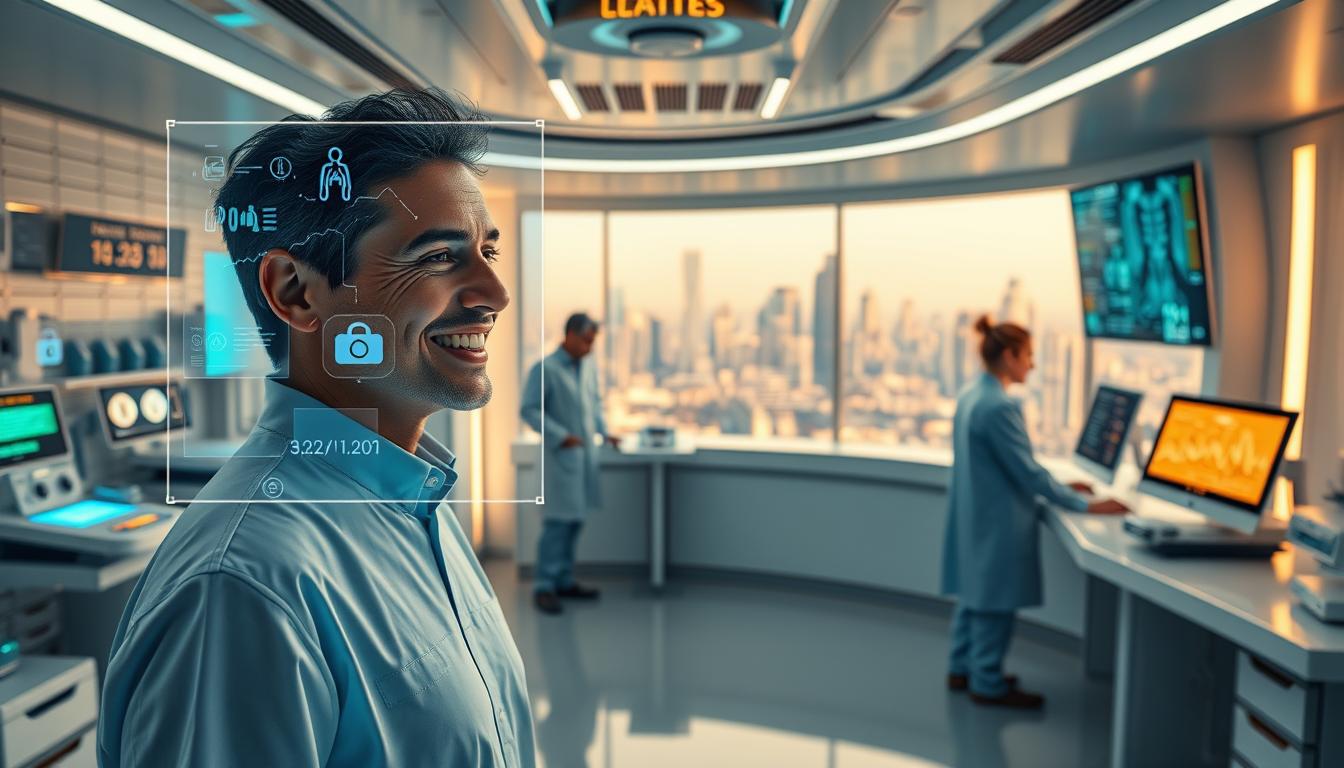Did you know that the integration of smart wearable sensors and IoT technologies is transforming healthcare from a conventional hub-based system to a personalized healthcare management system1? This shift marks the dawn of Preventive Healthcare 2.0, where technology plays a pivotal role in anticipating and preventing health issues before they escalate.
At the heart of this revolution are emerging trends like wearable sensors and digital health platforms. These tools enable continuous monitoring of vital signs such as heart rate, blood pressure, and body temperature, fostering a new era of personalized healthcare management1.
Modern tech tools are not just monitoring systems; they are revolutionizing how we approach patient care. By leveraging AI and machine learning, these tools can predict potential health issues, allowing for early intervention and significantly improving health outcomes1.
Key Takeaways
- Preventive Healthcare 2.0 focuses on proactive health management through advanced technologies.
- Wearable sensors and IoT devices enable real-time monitoring of vital health indicators.
- AI and machine learning enhance predictive capabilities, improving early disease detection.
- Personalized healthcare platforms tailor interventions to individual needs, boosting effectiveness.
- Integration of modern tech reduces healthcare costs and improves accessibility of care.
Introduction to Preventive Healthcare 2.0
Preventive Healthcare 2.0 represents a significant leap forward in how we approach medical care. This modern system emphasizes early detection and personalized interventions, marking a shift from traditional reactive methods. By integrating advanced technologies, it offers a proactive approach to managing health.
The Evolution of Preventive Care
Historically, healthcare focused on treating illnesses after they occurred. Today, the emphasis is on preventing them. Smart devices and remote monitoring have enabled continuous health tracking, allowing for early interventions2.
This evolution is driven by the integration of smart devices and IoT, which provide real-time data. These tools help identify potential issues before symptoms appear, improving outcomes and reducing costs.
The Role of Modern Technology in Transforming Healthcare
Technology plays a crucial role in this transformation. AI and machine learning analyze vast amounts of data, predicting health issues like heart attacks and strokes2. These tools enhance diagnostic accuracy and enable personalized care.
For instance, AI in oncology can detect cancer early by analyzing images and genetic data2. Similarly, in cardiology, AI predicts heart attacks by examining ECG patterns, showcasing technology’s impact on early detection and continuous tracking.
Digital transformation streamlines healthcare processes, improving efficiency and patient outcomes. Reliable data from these systems supports better decision-making, enhancing the overall care system.
The Rise of Modern Healthcare Tech Innovations
The integration of cutting-edge technologies is revolutionizing the healthcare industry, offering unprecedented opportunities for innovation and improvement. This shift is driven by advancements in IoT, AI, and blockchain, which are reshaping how healthcare is delivered and managed.
Impact of IoT and Wearable Sensors
IoT integration and wearable sensors are transforming patient monitoring practices by enabling real-time data collection and analysis. These devices allow for continuous tracking of vital signs, such as heart rate and blood pressure, which can help identify potential health issues before they become severe. For instance, studies have shown that remote monitoring programs can reduce heart failure readmissions by up to 50%3.
Wearable sensors are also becoming more sophisticated, with non-invasive devices gaining popularity due to their ease of use and effectiveness. This trend is expected to continue, with the market for non-invasive monitoring devices projected to grow significantly in the coming years3.
Revolutionary Advances in Artificial Intelligence
AI is playing a pivotal role in enhancing diagnostic accuracy and predictive analytics in healthcare. Machine learning algorithms can analyze vast amounts of data to identify patterns and predict potential health issues, such as heart attacks and strokes. For example, AI algorithms have achieved diagnostic accuracy comparable to or surpassing human capabilities in certain medical imaging tasks4.
AI is also being used to improve drug discovery, with the R&D-to-clinic translation success rate being less than 8% due to safety risks and low efficacy5. However, advancements in AI are helping to speed up this process, with Morgan Stanley predicting that AI could significantly accelerate drug discovery in the pharmaceutical industry4.
Blockchain’s Emerging Role in Healthcare
Blockchain technology is emerging as a key player in ensuring data integrity and interoperability across digital health systems. By providing a secure and decentralized platform for health data, blockchain can help reduce errors and improve the quality of care. For instance, the global healthcare AI market is projected to reach $45.2 billion by 2026, growing at a CAGR of 44.8% from 2021 to 20264.
Blockchain’s role in healthcare extends beyond data security. It also enhances the efficiency of clinical trials and drug discovery by providing a transparent and tamper-proof record of research and development activities. This can help reduce the time required for clinical trials by up to 30% by simulating patient responses to treatments4.
| Technology | Impact | Benefits |
|---|---|---|
| IoT and Wearable Sensors | Enables real-time monitoring of vital signs | Early detection of health issues, improved patient outcomes |
| Artificial Intelligence | Enhances diagnostic accuracy and predictive analytics | Faster drug discovery, improved accuracy in medical imaging |
| Blockchain | Ensures data integrity and interoperability | Secure and decentralized platform for health data, efficient clinical trials |
The integration of these technologies is not only improving the quality of care but also making healthcare more accessible to a broader population. With the global healthcare AI market projected to reach $188 billion by 2030, the future of healthcare is poised for significant advancements5.
Wearable Sensors and IoT in Patient Monitoring
Wearable sensors and IoT devices are revolutionizing patient monitoring by enabling real-time health tracking and continuous data collection. These technologies provide accurate and timely insights, empowering both patients and providers to make informed decisions.
Benefits and Real-Time Health Tracking
The integration of wearable sensors offers numerous benefits, particularly in monitoring vital signs like heart rate and blood pressure. These devices ensure accurate and real-time health status updates, which are crucial for early detection of potential issues. For instance, studies have shown that remote monitoring programs can reduce heart failure readmissions by up to 50%6.
IoT frameworks play a vital role in ensuring the continuous transmission of vital health data. This seamless data flow allows for proactive health management, reducing the need for frequent hospital visits. Smartwatches and fitness trackers are prime examples of how IoT enhances patient care through constant monitoring and timely interventions.
Challenges in Integration and Data Management
Despite their benefits, integrating wearable sensors and IoT devices into healthcare systems presents challenges. Interoperability and data standardization are significant hurdles, as different devices often operate on disparate systems, making data integration difficult. Additionally, the sheer volume of data generated can overwhelm healthcare providers, complicating effective data management.
Another challenge is the adoption and maintenance of these digital devices by healthcare providers. The learning curve and costs associated with implementing new technologies can be barriers, especially for smaller healthcare facilities. However, the long-term benefits often outweigh these initial challenges, making the integration a worthwhile investment.
“The future of healthcare lies in the seamless integration of wearable sensors and IoT, enabling a proactive approach to patient care.”
| Technology | Benefits | Challenges |
|---|---|---|
| Wearable Sensors | Real-time health monitoring, early issue detection | Data standardization, interoperability |
| IoT Frameworks | Continuous data transmission, enhanced patient care | High implementation costs, learning curve |
In conclusion, wearable sensors and IoT devices are pivotal in modern patient monitoring, offering precise real-time data and enhancing care quality. While challenges exist, the benefits make these technologies indispensable in the evolving healthcare landscape.
AI-Driven Diagnostic and Monitoring Tools
AI-driven diagnostic and monitoring tools are revolutionizing the way healthcare professionals detect and manage conditions. These innovations are enhancing diagnostic accuracy, enabling earlier interventions, and improving patient outcomes.
Enhancing Diagnostic Accuracy with AI
AI tools are advancing diagnostics by improving image interpretation and decision-making. For instance, AI algorithms can outperform experienced radiologists in diagnostic accuracy, particularly in oncology, where they identify tumors in breasts, lungs, and prostates with higher precision7. Studies indicate that deep learning algorithms achieve up to 94% accuracy in detecting certain conditions, surpassing human capabilities7.
AI’s capability to analyze large datasets for predictive insights is transforming patient care. Predictive analytics in population health management can identify patients at risk for chronic diseases, enabling targeted interventions that reduce healthcare costs by approximately 30%7. AI-driven diagnostic tools have shown a 20% reduction in diagnostic errors compared to traditional methods7.
The impact of AI is evident in specific clinical contexts. For example, AI in mammography has improved tumor segmentation accuracy by up to 25%, aiding in better treatment planning7. In emergency departments, AI optimizes patient triage and reduces waiting times, with algorithms capable of analyzing patient data to prioritize high-risk cases7.
AI also supports healthcare management by providing real-time suggestions to healthcare providers, critical in emergency situations7. Its role in genomic medicine includes monitoring emerging disease threats and refining risk predictions through genetic markers7.
Overall, AI-driven tools are enhancing the quality of care through improved diagnostics and management, leading to better patient outcomes and more efficient healthcare systems.
Digital Transformation in Healthcare Systems
Digital transformation is reshaping healthcare by enhancing operational efficiency and improving access to care. This shift is driven by technologies like AI, IoT, and blockchain, which streamline processes and ensure efficient data flow. As a result, healthcare providers can deliver higher quality services while reducing operational costs.
Streamlined Operations and Efficient Data Flow
One of the key benefits of digital transformation is the streamlining of healthcare operations. Automated systems reduce administrative burdens, allowing healthcare providers to focus more on patient care. For instance, electronic health records (EHRs) enable seamless data sharing, improving coordination among healthcare teams and enhancing the quality of care.
Efficient data flow is critical in modern healthcare. Integrated IT systems ensure that patient information is accessible in real-time, facilitating quicker decision-making. This not only improves service delivery but also reduces operational costs. Studies show that digital health systems can lower administrative expenses by up to 30%8.
Reducing Costs and Improving Patient Outcomes
Digital transformation also plays a vital role in reducing healthcare costs. By minimizing redundant processes and optimizing resource allocation, healthcare providers can allocate more funds to patient care. For example, remote monitoring programs have been shown to cut heart failure readmissions by 50%3, significantly reducing the financial burden on healthcare systems.
Improved patient outcomes are another benefit of digital transformation. With access to real-time data, healthcare providers can make more informed decisions, leading to better treatment plans and enhanced patient care. This shift towards data-driven decision-making is a cornerstone of modern healthcare systems.
| Technology | Impact | Benefits |
|---|---|---|
| Electronic Health Records (EHRs) | Enable seamless data sharing | Improve care coordination and reduce costs |
| Remote Monitoring Systems | Provide real-time patient data | Enhance early detection and reduce readmissions |
| AI-Driven Analytics | Facilitate predictive analytics | Support personalized treatment plans |
In conclusion, digital transformation is revolutionizing healthcare systems by streamlining operations, improving data flow, and reducing costs. These advancements not only enhance the quality of care but also empower healthcare providers to deliver more efficient and effective services.
Telehealth and Remote Patient Management
Telehealth has emerged as a groundbreaking solution, expanding access to care beyond traditional hospital settings and transforming how healthcare is delivered worldwide. This innovative approach leverages technology to provide continuous patient management, enabling early interventions and improving health outcomes. The COVID-19 pandemic underscored the effectiveness of telemedicine as a crucial healthcare innovation9.
Revolutionizing Access to Care
Telehealth services have grown significantly, offering virtual consultations and remote monitoring. This expansion is driven by the widespread adoption of smartphones, with 77% of US adults owning a smartphone, making telehealth more accessible10. Remote patient management facilitates continuous care, allowing healthcare providers to monitor conditions like diabetes and depression outside traditional settings. For instance, diabetic patients benefit from centralized platforms for tracking results, leading to quicker interventions9.
| Technology | Benefits | Challenges |
|---|---|---|
| Telemedicine Platforms | Enable virtual consultations and remote monitoring | Dependence on reliable internet connectivity |
| Mobile Health Apps | Provide real-time health tracking and management | Varied patient satisfaction and usability |
| Remote Monitoring Systems | Facilitate early detection and intervention | High implementation and maintenance costs |
“Telehealth is not just an alternative; it’s a necessity for equitable healthcare access.”
Telehealth programs have successfully reduced hospital strain, with remote monitoring showing a 50% reduction in heart failure readmissions11. These programs highlight how technology can enhance care accessibility, especially in rural areas. The future of telehealth aims to provide visibility across the entire care pathway, fostering a more holistic approach to patient management9.
By integrating telehealth into care pathways, healthcare systems can adopt a more preventative approach, improving patient outcomes and reducing costs. This shift is pivotal in addressing the healthcare needs of an increasingly connected world9.
Data-Driven Decision Making and Big Data Analytics in Healthcare
Big data analytics is revolutionizing healthcare by transforming how decisions are made and care is delivered. The integration of structured and unstructured data from various sources, including devices and electronic health records, enables predictive models that enhance patient care12.
Real-time data from devices is crucial for creating predictive models. These models help identify potential health issues early, improving outcomes. For instance, wearable devices provide continuous health monitoring, enabling timely interventions13.
Managing large amounts of health data is challenging due to diversity and volume. Advanced tools and technologies are essential for effective data management. Despite these challenges, big data analytics offers significant benefits, including improved care quality and cost reduction12.
Case studies show successful applications of predictive analytics in clinical settings. For example, predictive analytics has improved disease diagnosis and treatment efficiency in various healthcare facilities13.
Digital tools facilitate data analysis, driving actionable insights. These tools support clinical decision-making, disease surveillance, and public health management, making them indispensable in modern healthcare12.
Enhancing Quality of Care through Technology Integration
Technology integration is revolutionizing the quality of care by streamlining disease management and improving service delivery. Advanced models, such as AI-driven diagnostic tools, are enhancing treatment protocols and enabling early interventions14.
For instance, AI algorithms have improved tumor segmentation accuracy by up to 25%, aiding in better treatment planning14. Predictive analytics in population health management can identify patients at risk for chronic diseases, enabling targeted interventions that reduce healthcare costs by approximately 30%14.
The integration of digital technologies has also led to the development of innovative care models that combine diagnostics, monitoring, and patient services. For example, telehealth platforms have successfully reduced hospital strain, with remote monitoring showing a 50% reduction in heart failure readmissions.
| Technology | Impact | Benefits |
|---|---|---|
| AI-Driven Diagnostics | Enhances diagnostic accuracy and predictive analytics | Improves disease detection and streamlines treatment protocols |
| IoT and Remote Monitoring | Enables real-time health tracking and continuous data collection | Facilitates early detection and intervention, reducing readmissions |
| Telehealth Platforms | Expands access to care beyond traditional settings | Reduces healthcare costs and improves patient outcomes |
“Technology integration is the cornerstone of modern healthcare, enabling us to deliver higher quality, more personalized care.”
These advancements underscore the measurable improvements in patient outcomes driven by technology-forward care models, making them indispensable in the evolving healthcare landscape.
Sustainable Healthcare Practices and Environmental Impact
The healthcare sector contributes to over 4.4% of global greenhouse gas emissions, making sustainability a critical focus for modern healthcare systems15. As the demand for sustainable practices grows, digital transformation is playing a pivotal role in creating cost-efficient and environmentally friendly healthcare solutions.
Digital tools are reducing operational costs while promoting sustainability. For example, remote monitoring systems have cut heart failure readmissions by 50%, significantly lowering treatment costs and minimizing resource waste15. These innovations optimize resource allocation, reducing the environmental footprint of healthcare facilities.
| Technology | Impact | Benefits |
|---|---|---|
| Remote Monitoring | Reduces readmissions and resource use | Lowers costs, reduces waste |
| Digital Health Platforms | Enhances data management | Improves efficiency, cuts emissions |
| Predictive Analytics | Facilitates early interventions | Reduces long-term treatment costs |

By integrating sustainable practices, healthcare systems not only reduce costs but also enhance public health outcomes. This shift towards sustainability is essential for meeting future healthcare demands while protecting the environment15.
Preventive Healthcare 2.0: Staying Ahead of Health Issues with Modern Tech
Real-time monitoring and AI are revolutionizing healthcare by enabling early detection and intervention, significantly reducing hospital readmissions and mitigating risks. Studies show that remote monitoring programs have cut heart failure readmissions by up to 50%1, showcasing the power of proactive health management.
Hospitals are leveraging modern tech to integrate real-time data, enhancing their ability to manage patient risks effectively. For instance, AI algorithms can predict potential health issues like heart attacks and strokes, allowing for timely interventions that improve outcomes1.
Case studies highlight the benefits of rapid, data-driven decisions in reducing adverse events. For example, AI in oncology has improved early cancer detection by analyzing images and genetic data, demonstrating technology’s impact on continuous tracking and early intervention1.
Looking ahead, smart healthcare systems are poised to pre-emptively address health issues, enhancing patient outcomes and reducing costs. With 77% of health executives ranking AI among their top investment priorities14, the future of healthcare is increasingly data-driven and personalized.
Overcoming Barriers in Healthcare Digitalization
Healthcare digitalization faces significant challenges, primarily stemming from device heterogeneity and interoperability issues16. These challenges hinder the seamless integration of digital tools, creating obstacles for healthcare providers and patients alike.
Addressing Interoperability and Standardization Challenges
One of the most pressing issues is the lack of standard protocols. Without a unified framework, integrating diverse devices and systems becomes increasingly difficult. Studies highlight that infrastructure and technical barriers have a high Relative Frequency Occurrence (RFO) of 6.4%, underscoring the need for standardized solutions16.
| Challenge | Impact | Solution |
|---|---|---|
| Device Heterogeneity | Complicates data integration | Adopt standardized protocols |
| Interoperability Issues | Delays in care coordination | Implement middleware solutions |
| Data Fragmentation | Hinders predictive analytics | Use integration platforms |
Collaborative efforts between technology providers and healthcare systems are essential. By working together, they can develop tools that bridge gaps and enhance data flow, ultimately improving care quality and efficiency.
Economic and Operational Benefits of Advanced Healthcare Systems
Advanced healthcare systems are driving significant economic and operational improvements in the medical sector. These innovations are not only enhancing patient care but also streamlining hospital operations and reducing costs.
Impact on Hospital Efficiency and Resource Management
Hospitals are experiencing notable financial advantages by implementing advanced digital systems. For instance, these systems reduce administrative burdens and improve patient throughput. According to recent studies, remote monitoring programs have cut heart failure readmissions by up to 50%17, significantly lowering treatment costs and minimizing resource waste.
Data-driven insights are crucial for efficient hospital operations. Predictive analytics in population health management can identify patients at risk for chronic diseases, enabling targeted interventions that reduce healthcare costs by approximately 30%4. This approach allows for better allocation of resources, leading to enhanced patient outcomes and operational efficiency.
Operational changes are also leading to substantial cost savings. For example, AI algorithms can predict potential health issues like heart attacks and strokes, allowing for timely interventions that improve outcomes1. This proactive approach not only reduces hospital readmissions but also optimizes resource allocation.
| Technology | Financial Advantage | Operational Impact |
|---|---|---|
| Predictive Analytics | Reduces healthcare costs by 30% | Enables early detection and intervention |
| Remote Monitoring | Lowers treatment costs by 50% | Decreases hospital readmissions |
| AI-Driven Diagnostics | Enhances resource allocation | Improves diagnostic accuracy |
The integration of advanced healthcare systems is a testament to the transformative power of technology in the medical field. By embracing these innovations, hospitals can achieve long-term economic benefits while delivering high-quality patient care.

Patient Empowerment and Personalization with Technology
Patient empowerment is at the forefront of modern healthcare, driven by technologies that personalize and enhance care delivery. These tools not only improve patient autonomy but also ensure more informed decision-making.
Enhancing Patient Access and Informed Decision-Making
Digital platforms are making health information more accessible than ever. Patients can now monitor vital signs like heart rate and blood pressure in real-time, thanks to wearable sensors1. This accessibility fosters a more proactive approach to health management, enabling individuals to make timely decisions about their care.
Customized Care Through Predictive Data Insights
Predictive analytics is revolutionizing personalized healthcare. By analyzing data from wearable devices, AI can predict potential heart conditions, allowing for early interventions that improve outcomes18. This tailored approach ensures that treatment plans are specific to individual needs, enhancing effectiveness and efficiency.
Initiatives like remote monitoring programs have empowered patients, reducing heart failure readmissions by up to 50%1. These technologies not only improve care quality but also reduce healthcare costs, making them a cornerstone of modern patient-centered practices.
Emerging Trends: Future Technologies in Preventive Care
The future of preventive care is being reshaped by groundbreaking technologies that promise to redefine how we approach health management. From advanced AI systems to next-generation diagnostic tools, these innovations are setting the stage for a new era of personalized and proactive healthcare.
Generative AI and Virtual Assistance in Healthcare
Generative AI is poised to revolutionize clinical support and process automation. According to industry reports, AI-driven tools are expected to enhance diagnostic accuracy and streamline healthcare workflows19. These systems can analyze vast amounts of data, enabling early detection of potential health issues and improving treatment outcomes.
Virtual assistance is another key area where AI is making waves. Chatbots and virtual health assistants are becoming increasingly sophisticated, offering patients personalized health advice and real-time monitoring20. This level of interaction not only improves patient engagement but also reduces the burden on healthcare providers.
Innovative Diagnostic Platforms and Tools
Next-generation diagnostic platforms are raising the bar for accuracy and speed. These tools leverage machine learning algorithms to analyze complex data sets, providing faster and more precise results21. For instance, advanced imaging platforms can now detect abnormalities with unprecedented accuracy, enabling earlier interventions.
Wearable devices are also playing a crucial role in this transformation. By continuously monitoring vital signs, these devices empower patients to take a more active role in their health management19. This shift towards personalized health monitoring is expected to become even more prevalent in the coming years.
| Technology | Impact | Benefits |
|---|---|---|
| Generative AI | Enhances diagnostic accuracy and workflow efficiency | Improves patient outcomes and reduces provider workload |
| Next-Gen Diagnostics | Provides faster and more accurate results | Enables earlier interventions and better health management |
| Wearable Devices | Offers continuous health monitoring | Empowers patients and supports proactive care |
As these technologies continue to evolve, they will redefine the preventive care landscape. By adopting a strategic approach to integration, healthcare leaders can ensure that these tools are used effectively to improve patient care and outcomes.
Global Perspectives: Digital Transformation in Healthcare
Digital transformation is reshaping healthcare globally, with significant strides in the United States and beyond. The integration of advanced technologies has not only improved care delivery but also set new standards for patient management and data-driven decision-making.
Case Studies from the United States and Beyond
The U.S. has emerged as a leader in digital health innovation, with telehealth adoption surging by over 50% during the COVID-19 pandemic2. This trend reflects a broader global shift towards remote patient monitoring and ambient health systems, which have gained traction due to reduced in-person visits during lockdowns2.
Barriers to digital transformation vary across regions. In the U.S., cybersecurity concerns are paramount, with healthcare cyberattacks rising by 38% in 2022 compared to the previous year2. However, innovative strategies like the adoption of cloud computing and AI have enhanced data security and resource management1.
Success stories abound, such as Estonia’s nationwide digital health system, which leverages blockchain for data integrity and patient empowerment. This model has inspired other countries to adopt similar approaches, demonstrating the scalability of digital healthcare solutions globally1.
| Region | Trend | Challenge | Solution |
|---|---|---|---|
| United States | Increased telehealth adoption | Cybersecurity threats | Advanced AI and cloud integration |
| Estonia | Blockchain for data security | Interoperability issues | Standardized digital platforms |
| Asia-Pacific | Growing wearable tech market | Data privacy concerns | Stricter regulations and compliance |
These global perspectives highlight the transformative potential of digital technologies in healthcare, emphasizing the need for continuous innovation and collaboration to overcome existing barriers and ensure sustainable growth.
Conclusion
Modern technology is reshaping the future of preventive care, offering innovative solutions that enhance quality of life and improve patient outcomes. The integration of smart wearable sensors and IoT devices has transitioned healthcare from a conventional hub-based system to a personalized management approach1. This shift underscores the transformative power of science in advancing medical practices.
The role of science and digital innovation is pivotal in creating a more proactive and personalized approach to health management. Research highlights that predictive analytics and AI-driven tools have significantly improved diagnostic accuracy and early intervention capabilities1. These advancements not only enhance the quality of life for patients but also reduce healthcare costs and improve accessibility.
Looking ahead, the future of healthcare digitalization is poised for remarkable growth. Emerging technologies like generative AI and next-generation diagnostics promise to redefine how we approach preventive care18. By embracing these innovations, we can create a more sustainable and patient-centered healthcare system.
In conclusion, the fusion of science and digital innovation is driving a new era of healthcare. As we move forward, adopting a forward-looking perspective on technology will be essential for improving health management and enhancing the quality of life for individuals worldwide.
FAQ
What are the primary benefits of integrating technology into healthcare systems?
How does artificial intelligence contribute to healthcare?
What challenges does the healthcare system face in adopting new technologies?
How can telemedicine improve access to care?
What role does data play in modern healthcare management?
How can technology enhance patient empowerment?
What are the potential risks associated with digital health tools?
How can healthcare providers reduce costs using technology?
What does the future hold for healthcare technology?
Source Links
- Recent Advancements in Emerging Technologies for Healthcare Management Systems: A Survey – https://pmc.ncbi.nlm.nih.gov/articles/PMC9601636/
- Healthcare technology trends 2023–2030: 13 digital health trends to shape the next decade – https://medium.com/@pragmaticcoders/healthcare-technology-trends-2023-2030-13-digital-health-trends-to-shape-the-next-decade-56e7a4344416
- Tech-Enabled Health: Revolutionizing the Standard of Care – https://www.globalxetfs.com/tech-enabled-health-revolutionizing-the-standard-of-care/
- The 10 Biggest Trends Revolutionizing Healthcare In 2024 – https://www.forbes.com/sites/bernardmarr/2023/10/03/the-10-biggest-trends-revolutionizing-healthcare-in-2024/
- Revolutionizing Healthcare: Top Trends Shaping the Medical Device Industry | HTEC – https://htec.com/insights/blogs/revolutionizing-healthcare-top-trends-shaping-the-medical-device-industry/
- Recent Advances in Wearable Sensing Technologies – https://pmc.ncbi.nlm.nih.gov/articles/PMC8541055/
- Revolutionizing Healthcare: The Power of AI in Medical Diagnosis – https://www.linkedin.com/pulse/revolutionizing-healthcare-power-ai-medical-diagnosis-anton-dubov-sd1xc
- Are Health Information Systems Ready for the Digital Transformation in Portugal? Challenges and Future Perspectives – https://www.mdpi.com/2227-9032/11/5/712
- Awell – Telemedicine 2.0: Focusing on the Entire Care Pathway – https://awellhealth.com/blog/telemedicine-2-0-focusing-on-the-entire-care-pathway
- The transformation of health care for patients – https://journals.lww.com/jaanpresourcecenter/Pages/transformation.aspx
- Remote monitoring and telemedicine – PMC – https://pmc.ncbi.nlm.nih.gov/articles/PMC6937516/
- The use of Big Data Analytics in healthcare – https://pmc.ncbi.nlm.nih.gov/articles/PMC8733917/
- Systematic analysis of healthcare big data analytics for efficient care and disease diagnosing – https://pmc.ncbi.nlm.nih.gov/articles/PMC9792582/
- Next in health services: trends and analysis for 2025 – https://www.pwc.com/us/en/industries/health-industries/library/healthcare-trends.html
- Strategies and tactics to reduce the impact of healthcare on climate change: systematic review – https://www.bmj.com/content/387/bmj-2024-081284
- Barriers and facilitators to utilizing digital health technologies by healthcare professionals – https://pmc.ncbi.nlm.nih.gov/articles/PMC10507089/
- The economic potential of generative AI: The next productivity frontier – https://www.mckinsey.com/capabilities/mckinsey-digital/our-insights/the-economic-potential-of-generative-ai-the-next-productivity-frontier
- Technology and the Future of Healthcare – https://pmc.ncbi.nlm.nih.gov/articles/PMC4147743/
- The Future of Healthcare with Industry 5.0: Preliminary Interview-Based Qualitative Analysis – https://www.mdpi.com/1999-5903/16/3/68
- How Technology Will Transform Employee Benefits in the Next Five Years – https://www.aon.com/en/insights/articles/how-technology-will-transform-employee-benefits-in-the-next-five-years
- The future of public health – https://www2.deloitte.com/us/en/insights/industry/health-care/the-future-of-public-health.html




